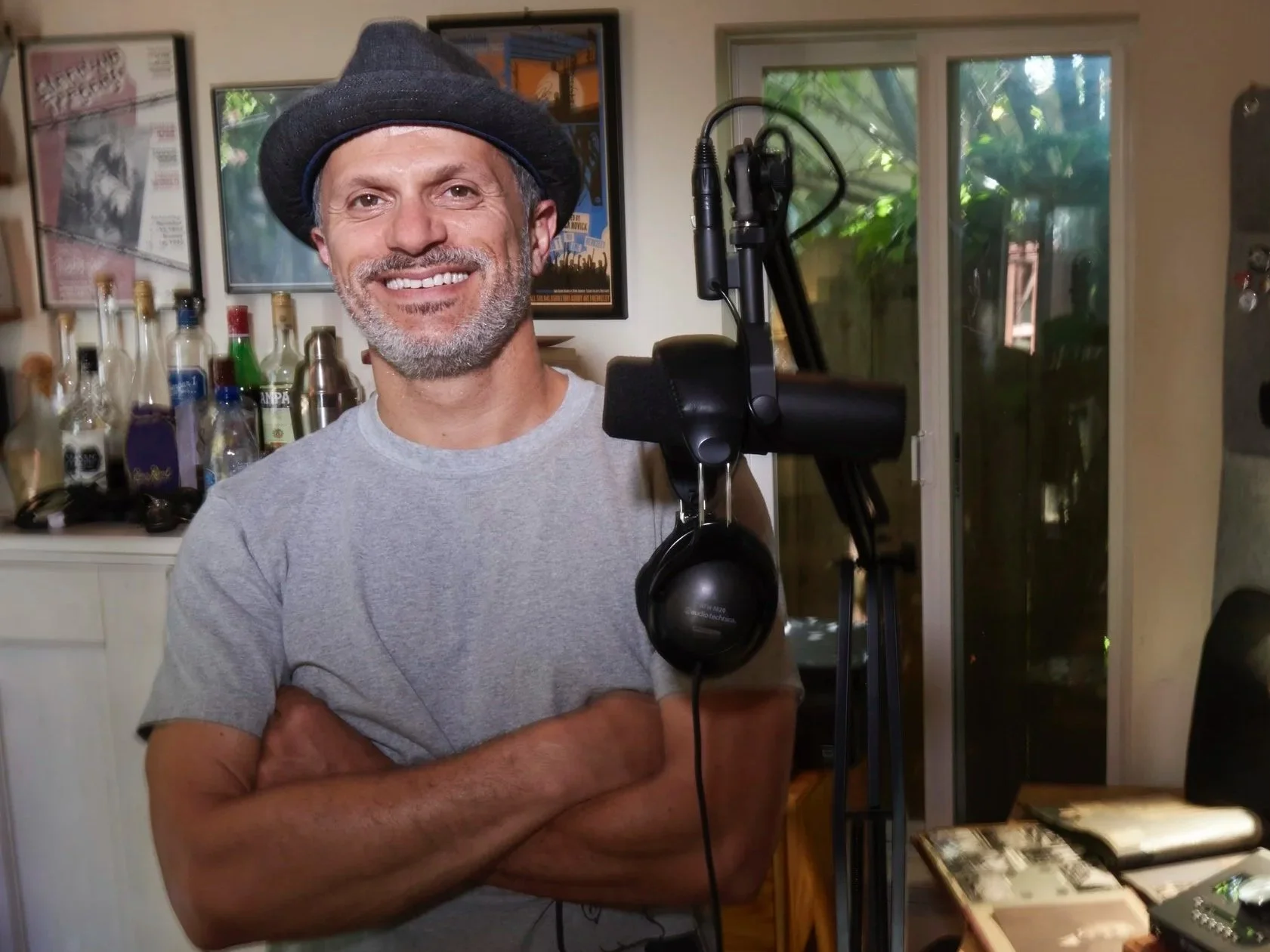Dan Wolf
Dan Wolf, already a creative and provocative playwright, director, and actor, is writing a book. It might just provide a roadmap to the future of truly impactful remembrance work.
Wolf is a member of Widen the Circle's 2025 Berlin Fellowship, an in-depth yearlong learning program. Along with the late director Jens Huckeriede, he developed Sound in the Silence, a unique and powerful performance-based remembrance project that operates on multiple levels. The basic concept brings together people, typically high school students, interested in arts such as theater, music, dance, rap, and writing.
The group visits a memorial site where trauma and oppression have occurred. Participants spend three intensive days learning about the site’s history. Then, with the help of group leaders, they develop individual artistic expressions based on what they learned. Finally, the group comes together and spends three more days melding those artistic expressions into a final performance, often delivered at the memorial site.
Special Event
Join us for a virtual conversation with Dan Wolf. Wednesday, November 12 at 1 pm ET (19:00 CET). Register here.
“The show usually moves around the location," Wolf says. "Think of it as a moving installation, guided tour, performative walk. … We want it to be seen as an almost borderless experience for everybody involved.”
For example, during a performance at the Ravensbrück concentration camp memorial, audience members were asked to close their eyes. They were then approached by cast members who escorted them from outside the camp, through the gate used by camp guards. When they opened their eyes, they were confronted with a completely new perspective, from outside to inside the camp.
“We don’t want to let the audience off,” says Wolf. "We want to be provocative. We want to make you think. We want to make you see these memorial sites in a different way. We want you to understand it in your head and your heart and your gut, really viscerally throughout your body.”
Rehearsing for a Sound in the Silence performance
A presentation of Sound in the Silence uses the surroundings as part of the performance.
As fewer and fewer Holocaust survivors are alive to tell their stories, how do you create remembrance with emotional impact? Wolf looks to the arts and the power of performance.
His perspective begins with his own family history. Wolf has Polish and German-Jewish roots. His great-grandfather and his great-grandfather's two brothers formed a very popular comedy act in Germany in the early 1900s. Because they were Jewish, they were forced to stop performing by the Nazis in 1933, and one of the three brothers was killed at the Theresienstadt camp.
As a young person growing up in San Rafael, California, Wolf had a strong interest in theater and attended a high school with a special theater program. The teacher acted as an advisor but the students were expected to do all the work, from developing the performances to selling the tickets.
“A lot of the lessons I learned there are the foundation for my work,” he says. “I learned how to write my own pieces. I learned how to direct. I learned how to teach. We had to raise money. We had to learn how to do the lights.”
He also developed a love of hip-hop music and became interested in rapping, inspired by the Beastie Boys, a band from New York City whose members were Jewish. “I always say the Beastie Boys brought [hip-hop] to my neighborhood because they look like me, and then I found out they were Jews and I thought: Oh, ok.”
The Brothers Wolf were a popular comedy group in Hamburg until 1933.
Wolf formed a rap group with some of his friends from a college theater program. The group took off when a teacher encouraged them to write a play using rap. The play they wrote, “Beatbox: A Raparetta,” was a parable about two step-brothers who are hip-hop street performers.
“What was cool about it is that the entire sound track for it was created live. So beat-boxing, vocal drum percussion, and the deejay was basically the orchestra. So we were really experimenting with how do we take the form and function of theater musical and infuse it with hip-hop aesthetics,” he says.
The group, called Felonious, began opening for major acts in the San Francisco Bay Area. They were invited to perform in New York and also in Germany, in Hamburg and Berlin. The operetta was later published by a nonprofit organization and was performed by others for the first time in 2024 in Houston.
Before Sound in the Silence, Wolf, working with Hamburg filmmaker Jens Huckeriede, developed a play called “Stateless.” The two met when Huckeriede was creating a film about the Brothers Wolf.
“‘Stateless’ was this play that really connected my family history. It paralleled the German Jewish experience with the African American experience. So in the play we go to a concentration camp, and it triggers not only the history of the concentration camp but it triggers the prison industrial complex. In our research we realized that the Nuremberg Laws that Hitler instituted were modeled after the Jim Crow laws, so we had a section in the play where we mixed the Jim Crow laws and the Nuremberg Laws together and really paralleled them.”
The plot of the play involves two friends, one of German Jewish descent and one African American, taking a trip together. Wolf’s character finds a letter from his grandfather, and the pair go on a journey exploring his heritage. The relationship and backgrounds of the two friends intertwine and divert in dramatic ways.
The play premiered in San Francisco in 2006. They brought it to Hamburg and Berlin, then went to Ravensbrück to do hip-hop theater workshops with German youths. “This is where we started to think about Sound in the Silence,” Wolf says. “This is where our art forms really merged together.”
A turning point came when the cast took a guided tour of Ravensbrück. The power and emotion of that space enveloped Wolf and the others. “I was paralyzed. I didn’t really know what to do or how to progress or move forward,” he says.
The other performers began responding through their art. One of the cast members began beatboxing, another started free-style rapping, with very raw lyrics about what they had learned and how it resonates in today’s world. Dancers began to dance.
“This really started to spark some thinking around how can art really be a conversation starter?; how can we get out of our own way?; how can we kind of turn off that kind of conscious mind and move into the subconscious mind to deal with a lot of this trauma?, because it’s really trauma.”
From that experience, Wolf and Huckeriede started thinking about Sound in the Silence — a performance created not with professionals but with young people who come together in a place of trauma and oppression, learn about that place, and put the learning and their emotions into an original performance.
“In Sound in the Silence, I’m not the protagonist. I’ve extracted myself out of it and in a way we’ve put the participants in the position of being the protagonist. And instead of my family history, we’ve extracted that and put the history of the location in there,” says Wolf.
“You need to have the deep dramaturgical information about the place so that you have really informed emotions, ideas, impressions about what happened here. It’s not enough to show up and say oh, something really bad happened here; now I’m going to rap about it. You have to know what happened in a real holistic way,” he says.
"We don’t want to tell you what you should feel or think. We want to use art forms that are dealing with the spaces in between."
Many performers have told Wolf that participating in Sound in the Silence has had lasting impact on the them.
“I’ve watched these young people change, and they’ve told me [later] how life-changing it was,” says Wolf. “It’s an unintended but beautiful aspect and result of the project.”
The book Wolf is working on dives into the methods used to create a Sound in the Silence performance. Over more than a dozen years of working on the project with young people and adults alike, with skilled performers and with newcomers, with people who have a deep connection with the history and those who know little or nothing about it, he has come to understand that it can be used to focus on oppression and remembrance in any community; it’s not limited to telling the story of Jews during the Holocaust. And he wants to help people understand how to produce their own performances.
He has also piloted this model as a school-based project, with 150 students at an Oakland, Calif., high school. Ericka Huggins, once a leader of the Black Panther Party, spoke to the students during that project.
While Wolf has played the lead role in creating the Sound in the Silence model, its richness and flexibility have developed over the years. “It’s influenced greatly by the hundreds of people who have touched it,” he says. “That’s the best thing about it; it’s a living, breathing organism.”
More: Learn more about Dan Wolf and his projects at dan-wolf.com.
Watch a video about creating a Sound in the Silence production.





